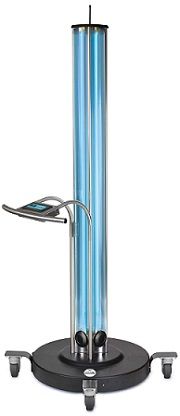UV Light Kills C. difficile, Saving Dollars and Lives
Considered safe and effective in killing certain types of bacteria, ultraviolet-C light, when used to disinfect hospital rooms, could prevent Clostridium difficile infections and potentially save millions of dollars.

Conducted at the Hospital of the University of Pennsylvania over the course of a year, a study published this week in Infection Control & Hospital Epidemiology highlights the value of disinfecting hospital rooms with ultraviolet C (UV-C) light.
Clostridium difficile infections (C. difficile) are common, costly, and potentially fatal. Often transmitted in hospitals, they can be an unpleasant and costly consequence of entirely unrelated admissions. Short-wavelength UV light can kill microorganisms, including C. difficile bacteria.
In three of the hospital’s hematology-oncology units, the researchers supplemented normal disinfection protocols with the use of UV-C disinfection robots (made by Clorox, pictured above) following 21% of patient discharges over the course of the year. Subsequent patients in these rooms had a 25% reduction in incidence of C. difficile infection, while the units that just used standard cleaning methods actually saw an increase of 16%.
Clinical effectiveness aside, the additional disinfecting step added only 5 minutes to room turnaround. The study estimates that the simple step could save the hospital between $350,000 and $1.5 million annually in healthcare costs. UV-C disinfection, particularly by robot, is considered safe and effective.
The use of the UV-C robots could be tailored to disinfect hospital units or rooms of patients at specific risk. The study concludes that “Targeted deployment of UVGI to rooms of high-risk patients at discharge resulted in a substantial reduction of CDI incidence without adversely impacting room turnaround.”
While seemingly effective against the spread of C. difficile, UV-C disinfection does not kill all hospital-borne infections, and in the study it showed no impact on Staphylococcus aureus, commonly known as MRSA. Still, cutting down C. difficile frequency alone could be a major benefit. Further studies may be needed to convince other hospitals to invest in the process, but early indications are that the introduction of UV-C disinfection could save healthcare costs and even lives.
(photo courtesy of Clorox Healthcare)
Related Coverage:
Deploying Bacteriophages Against Clostridium Difficile Infections
A Case Study of Clostridium Difficile Infection in Hemato-Oncological Patients
Clostridium difficile Disparities by Race: Black Patients Face Higher Risk of Severe Infection